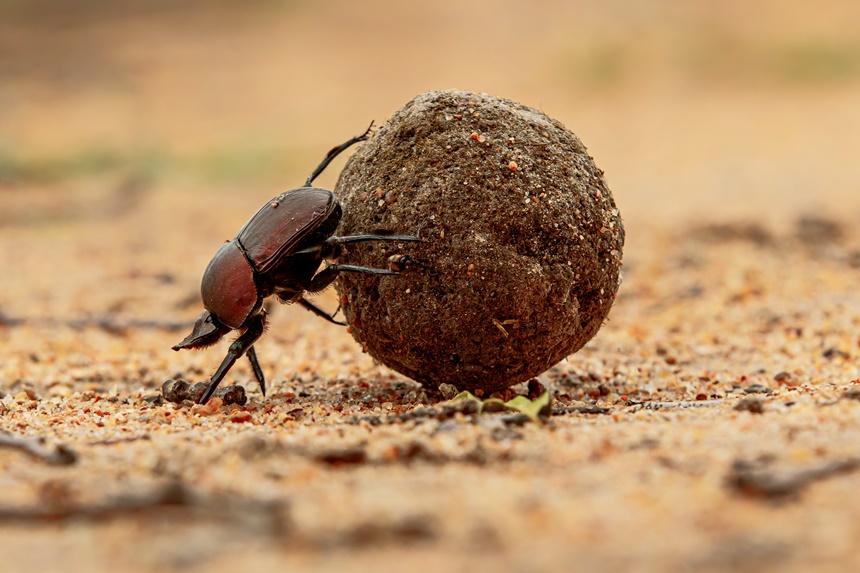Greek mythology holds that Zeus punished the murderous tyrant-king Sisyphus by banishing him to Tartarus for eternity, where he has to roll a big rock up a hill, only to have it tumble back down as he nears the top. Big deal – he got off easy.
Zeus could have condemned him to push a towering sphere of solid excrement that weighed ten times more than he did, walking backwards the whole time, and then dig a hole, bury the thing, and return to where he started to repeat the process endlessly. It would’ve been worse yet if old Sisyphus was obliged to pack each colossal poop-orb into shape, mucking poo from an infinite pile. With his bare hands, no less — and it’s not like the underworld’s torture-vault likely has a place to wash off at the end of the day.
While it sounds like a punishment dreamed up by a sadist, it’s an actual job description, except that it takes place daily here on Planet Earth, not in a mythological dungeon. It’s lucky for us that there are many who eagerly take on this Herculean task as their life’s calling, because things would be a lot harder for humans without them. They’re like a tireless army of Oompa-Loompas, except without the racist overtones, and using a different kind of fudge. If not for these workers, our grocery bills would be even higher than they are now, and our world would be hotter than it already is. Plus, we’d miss out on their endlessly entertaining YouTube videos.
There are about 5,700 species of coprophagous, or manure-munching, beetles in the family Scarabaeidae. Aptly called dung beetles, they can be found in most natural environments around the world outside of Polar regions. While their lifestyle is admittedly less than glamorous, they add at least $5.9 billion to the U.S. economy each year in the form of ecosystem services like water-quality protection and reduced pest populations.
By quickly burying livestock feces in pastures and on rangeland, dung beetles conserve nitrogen and aerate the root zone, boosting soil fertility. They also help control diseases and parasites of livestock, in some cases reducing parasites by as much as 90 percent. In the U.S., this saves farmers an estimated $380 million annually. Just imagine if we had to cover these costs at the grocery store.
Dung beetles also reduce greenhouse-gas emissions by as much as 12 percent in pastures. This is because breaking up larger fecal deposits into balls of dung short-circuits the production of methane, a greenhouse gas that’s 28 times more potent than carbon dioxide at warming the planet.
Although dung beetles are pervasive, they’re surprisingly fragile. Dung beetles can be harmed by pesticide residues and cattle dewormer, for example. Some farmers are motivated to adopt organic practices to safeguard dung beetles’ benefits to their farm operations.
In a way, we are rediscovering the importance of dung beetles, something the ancient Egyptians knew very well. Dung beetles were revered by Egyptians, who saw the dung-ball as representing the cycle of life, and dung beetles feature prominently in early sculpture and other art forms.

As fun as it is to watch dung beetles roll comically large balls of crap around, not all of them do this. Scientists have classified dung beetles into three general types: rollers, tunnellers, and dwellers.
Like rollers, tunnellers also fashion poop-spheres, which they bury in branched tunnels directly under or adjacent to a mother-lode of dung. Dwellers, as their name suggests, make themselves at home inside a cow-pie (or elephant, bison, bear, etc.), competing with rollers and tunnellers for the precious resource, and helping to break it down faster.
Rollers, able to bury 250 times their weight in crap each night, have an incentive to work hard that Sisyphus lacks: They get to make bug-love after a long night of poop-boulder budging. Generally, a pair of dung beetles works together to form the sphere, but the male usually does the pushing. Of the ball, I mean. Once the last ball is rolled away and buried, the two beetles mate underground. Afterward, the female lays eggs in the ball, which will nourish her babies.
Fittingly, there is a genus of dung beetle named Sisyphus, encompassing about 90 species. Even though every day is a crappy day for those dung beetles, at least their endeavors, unlike those of the legendary Sisyphus, make the world a better place.
Become a Saturday Evening Post member and enjoy unlimited access. Subscribe now




Comments
Thank you, Bob, for your consistently salient and interesting comments. I don’t often reply, but always enjoy what you have to say. Best wishes!
Another great feature, Paul! Paragraphs 3 to 6 get down to the nitty-gritty of these largely non-celebrated beetles, and their importance in the ecosystem spectrum. I appreciate the links. Wonderful title here. I bet Paul McCartney would appreciate it too.
He dabbled in farming around 1974, and it was the inspiration for my own personal favorite Wing’s song, Junior’s Farm; even more than Live and Let Die! I had a very good time seeing him in concert (1993) with Linda, but he didn’t perform ‘Farm’. Oh well. It seems there’s always a couple of favorites that get cut from most concerts, damn it. I think they rotate playlists as to not get burned out.